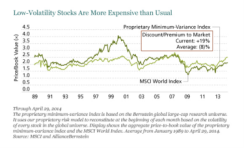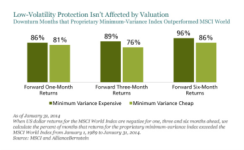Protecting against stock market declines is a top priority for many investors. But with low-volatility stocks looking expensive today, will they get the job done if equities fall from recent peaks?
As investors prepare for the next potential downturn, there’s been a meaningful shift into low-volatility stocks during the past few years. That’s why these shares look so pricey today.
We have advocated holding stocks that can provide stability in turbulent markets as part of a balanced approach to equity investing. In our view at AllianceBernstein, investors should consider owning a combination of return-seeking equity strategies that are typically somewhat riskier, along with risk-reducing portfolios that provide protection in a downturn. Our research suggests that this approach should yield more consistent returns. The precise prescription depends on an investor’s long-term goals and risk appetite.
But given the starting point today, will low-risk equity strategies that are designed to provide some protection in down markets meet expectations? To answer this question, we decided to look to history for some guidance. We constructed a proprietary minimum-variance index of global stocks with low-volatility characteristics from 1989 through the present. The companies represented had less sensitivity to the economic cycle and their stocks were less volatile, with lower-return correlations compared with the broad market.
As of the end of April, the price-to-book value of the minimum-variance index was about 19 percent higher than the MSCI world index. That’s an improvement from early 2009, when it was valued at 43 percent higher than the market. Yet it’s still more expensive than the 25-year average (see chart 1).

When markets were choppy, these stocks typically provided protection. Our research shows that in months when equities declined, the minimum-variance index outperformed the broad market 83 percent of the time.
What about valuation? To answer the question we’re facing today, we broke months down into periods when low-volatility stocks were either more expensive or cheaper than the broader market.
There wasn’t much of a difference. Whether the minimum-variance index was cheaper or more expensive than the market, it still outperformed the broader index more than 80 percent of the time during a down month (see chart 2). And even during the 20 percent of the time it didn’t outperform, low-volatility protection usually kicked in during the following months. When equity markets fell for three to six months, expensive low-volatility stocks actually did an even better job of mitigating the damage.

There’s a plausible explanation for these findings. Valuation isn’t necessarily correlated with the defensive elements that are embodied by low-volatility stocks. And these companies are less sensitive to changes in growth and interest rate expectations, which often trigger a short-term market decline.
Certain conditions may lead to tougher challenges. For example, when markets expect rising interest rates without the accompanying economic growth, low-volatility stocks probably won’t work as well as usual. In 1994 low-volatility stocks underperformed in a down market. They continued to trail the benchmark during the following three months as the U.S. Federal Reserve raised interest rates more than investors had expected, threatening economic growth.
But that’s not where we are today. The Fed has made clear that interest rates will only rise if U.S. economic growth prospects are improving. So history suggests that even though low-volatility stocks are a bit pricier than usual, they will help shield portfolios if equity markets fall from their peaks. And by taking an active approach, we think a portfolio can avoid stocks that are more vulnerable to a protracted rise in interest rates — which tend to function as proxies for bonds — and improve the chances of success in a downturn.
Sharon Fay is head of equities and Kent Hargis is portfolio manager of low-volatility equities services at AllianceBernstein.
See AllianceBernstein’s disclaimer.
MSCI makes no express or implied warranties or representations and shall have no liability whatsoever with respect to any MSCI data contained herein. The MSCI data may not be further redistributed or used as a basis for other indexes, any securities or financial products. This report is not approved, reviewed or produced by MSCI.
Get more on equities.






